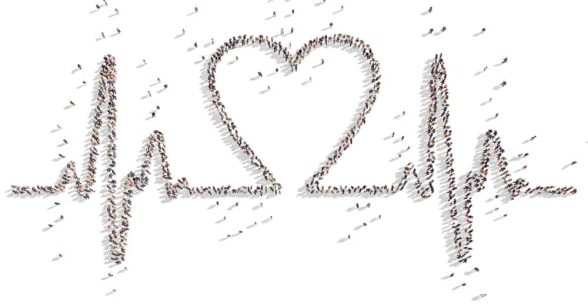For Us, By Us: Chronicling Disability Representation in Media
“I’ve got a great story for you! It’s about my life as a disabled person. It’s never been made, and I think it would be something great that you could make to show the world what it’s like to be me!”
This is a recurring email we get. It’s a message we receive on social media. We hear it over and over: disabled people are desperate for representation. Desperate to have their story told, desperate to feel like they have a place in this world.
When we tell people that we are a director and screenwriter duo, that we are working to make our own television, and that we analyze disability in media for a living, everyone always has a story that needs to be told, and we don’t disagree.
It’s one of the major reasons that we have become so involved in researching, analyzing, and understanding disability representation. In order to talk about representation, we felt it was important that we understood what representation actually exists. Also, what is that representation saying about disability?
What we’ve discovered is that most people have little understanding about what makes disability representation good. This is true for disabled people as well as nondisabled people. Disability representation that is truly inclusive and not from the nondisabled lens is so fleeting that we suspect that even most disabled people don’t even know what good representation is.
We also have such little representation that is overt, that involves actual disabled voices, creators, and actors that we’ve been forced to cling to what is there. Disabled people can be fiercely protective of something they relate to or feel drawn to even if the representation is not great, or worse, actually causes harm to the broader community.
But what is really going on in Hollywood with disability representation? Because by the numbers, per our research, disabled people are all over television. Our latest study saw 216/250 television shows featuring at least one disabled character, with 1342 disabled characters total So, why are disabled people not truly being represented?
Dom started #FilmDis while he was in college to talk about disability representation in the media. At the time, he had no idea that this discussion would lead to the creation of our media monitoring group, FilmDis. But here we are, almost a decade later, watching 250 television shows per study. They’re usually released annually, although our latest was a twofer—covering what we call “the pandemic years,” from 2020-2022, as we discuss how lockdown impacted representation.
This year was the third study released; we can now really delve into the patterns we are seeing between our studies. The patterns answer a lot of the questions that we’ve had, and paint a disconcerting portrait of where representation is and has been going. We all need to be concerned—not just about disability representation, but all representation.
The trends we see in the disabled community encompass the trends we see throughout all forms of representation; we believe that anyone saying things are getting better is not paying attention to what is happening. So, what is happening?
First, you won’t be surprised to know that white cisgender male representation permeates all forms of representation. It’s insidious in the disabled community, with white cisgender disabled male representation accounting for close to 40% of all disabled representation (522 characters). That’s more than all Black disabled representation (18%) and all Indigenous and People of Color (IPOC) representation (16% total) combined. That’s also 163 more characters than disabled cisgender white females.
Second, we keep seeing the same disabled communities represented, and the same disabled communities excluded over and over.
Three studies show that addiction, chronic disability, neurodivergence, mental health, people with multiple disabilities (often addiction combined with mental health), and cancer remain the most represented categories. These have been the top five most represented, although they change order within the top five, throughout all our studies. Likewise, the categories with the least disability representation have also remained constant, although they too have changed order within the bottom five, throughout our three studies.
Those communities are: Blind/Low Vision, Deaf/Hard of Hearing, learning disabilities, Dwarfism, and intellectual disabilities. This says to us that Hollywood devalues actors in these communities. They don’t allow these actors the opportunity to audition, let alone be cast.
Just to show how vastly different representation is, you can look at the number in the most represented category of addiction. We found 289 disabled characters dealing with addiction. By contrast, the intellectual disability community had only four characters. And this was a two-year study so that is four characters in two years.
Abysmal.
People look at the 1342 disabled characters our last study found and think disability must be represented well, with “that many” characters. However, we had to break down what those characters are like in order to understand why this is not really as good as may appear.
When we break down representation, we want to know everything about it, so we study everything from race to gender and gender identity. We analyze sexuality, part type (lead, supporting, bit, extra), age, and whether they are engaging in disabled mimicry or not.
Disabled mimicry is an important part of why disabled people often don’t feel represented. For those not in the know, disabled mimicry is the act of portraying disability, typically for a role on stage, in film, or on television, when you are either not disabled at all or don’t have a similar disability to the character you’re portraying.
The rampant amounts of mimicry, which is in turn often rewarded with statues, praise, and greater notoriety, has made us passionate about our own television show creation, and the development of authentic stories with authentic casting.
One factor we didn’t understand until we started doing this study is that there is disabled representation, but most of it is one-off, throwaway, bit characters. These are characters that you see in maybe one or two episodes of a show then never hear from again. They are not lead or supporting characters that you get to know over the course of a series.
This is an easy way that Hollywood is including disability without trying to include disabled stories, an important distinction. We found that half of all disabled representation on television is bit role representation.
We counted slightly more actors than characters (1348 actors to 1342 characters) simply because more than one actor can portray the same character as seen on shows like “This Is Us.” Truthfully, for most actors playing disabled characters, we don’t actually know if they’re disabled or not. This is for multiple reasons.
We mentioned above that most characters are bit characters; when you’re a bit character you may not get a credit for your role. If you do, there may be nothing known about you as an actor. Disabled actors don’t get as many opportunities to audition and, therefore, to perform. As a result, less is known about these actors.
Some disabled actors who can hide their disabilities don’t disclose for fear of losing work—and rightfully so. Also, most disabilities portrayed are not portrayed by actors who are read as visibly disabled.
We can’t tell you the number of disabled actors we know who have been told they should keep quiet about their disability. This includes an actress with a progressive disability who told us that, as her disability began to visibly manifest, she lost not only her management team but also industry access, including opportunities to audition.
All of this makes disabled mimicry a rampant phenomenon. We do extensive research to try to determine who is engaging in mimicry or not.
With 843 actors with unknown disability status, and 395 actors engaging in disabled mimicry, that leaves only 110 actors that we know are disabled or a little over 8% of actors playing disabled characters are disabled themselves. That’s 2% less than our previous studies, so that number has decreased during the pandemic years. We’re interested to see if it goes back up now that the pandemic is supposedly “over.”
As you can see, Hollywood is not good with disability and intersectionality. Despite significant overlap in the LGBTQIA2S+ and disabled communities, there were only 82 disabled LGBTQIA2S+ characters. This is the first study in which we found any type of trans disabled representation beyond a few trans women (thank you, “Pose”), but it’s limited to just 10 trans, non-binary, and gender non-conforming disabled characters.
We could go on and on about all the ways that Hollywood is failing the disabled community, but you can read about it further in our 165-page paper, our fact sheet, or the Easy Language version of our study at our website.
Our conclusion is that it’s 2023 and disabled people are tired of not being heard or seen in Hollywood—on television, in films, and beyond. We see the connection between the mistreatment of disabled people and disabled representation. Things will not get better until representation changes in the right ways; we now have the data to show that things are not going in the right direction.
Disabled people need to be involved in creating stories in Hollywood, and we need to be involved in telling those stories at all levels of creation. We deserve the accommodations necessary to allow us to create—and pay our bills while doing so. Hollywood needs to stop rewarding nondisabled actors for playing roles they don’t have the nuance or complexity to understand. They need to realize that disabled people are more than props, and that our stories are more than plot devices to add drama, horror, or comic relief.
Disabled people deserve more.
About Rooted In Rights
Rooted in Rights exists to amplify the perspectives of the disability community. Blog posts and storyteller videos that we publish and content we re-share on social media do not necessarily reflect the opinions or values of Rooted in Rights nor indicate an endorsement of a program or service by Rooted in Rights. We respect and aim to reflect the diversity of opinions and experiences of the disability community. Rooted in Rights seeks to highlight discussions, not direct them. Learn more about Rooted In Rights



